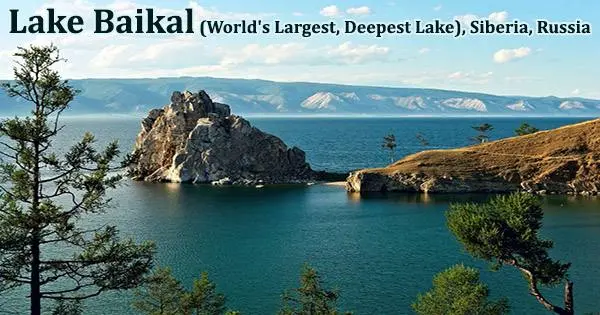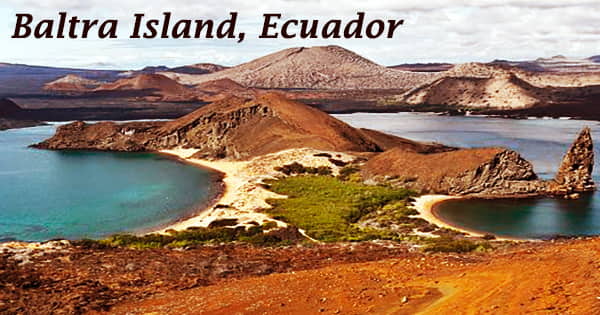The largest freshwater lake and deepest lake in the world are both found in Lake Baikal (/baɪˈkɑːl, -ˈkæl/, Russian: Oзеро Байкал, romanized: Ozero Baykal (ˈozʲɪrə bɐjˈkaɫ), also spelled Ozero Bajkal). It is situated in the Russian province of Irkutsk and the republic of Buryatia in the southernmost region of eastern Siberia. Lake Baikal is the largest freshwater lake in the world by volume, with 23,615.39 km3 (5,670 cu mi) of water. It holds 22-23% of the world’s fresh surface water, more than all of North American Great Lakes combined.
Its area is some 12,200 square miles (31,500 square km), with a length of 395 miles (636 km) and an average width of 30 miles (48 km). With a maximum depth of 1,642 meters (5,387 feet; 898 fathoms), it is both the deepest and oldest lake in the world, having existed for between 25 and 30 million years. At 31,722 km2, Belgium is somewhat larger at 12,248 sq mi. By surface area, Lake Baikal is the seventh-largest lake in the world. It is one of the purest lakes in the world. It is located in southern Siberia and has a somewhat crescent shape. In 1996 it was declared a UNESCO World Heritage Site.
Numerous of the thousands of plant and animal species that call Lake Baikal home are indigenous to the area. On the eastern side of the lake, where the mean temperature ranges from a winter minimum of -19 °C (-2 °F) to a summer maximum of 14 °C (57 °F), the Buryat tribes who live there raise goats, camels, cattle, sheep, and horses. Known as the ‘Galapagos of Russia’, its age and isolation have produced one of the world’s richest and most unusual freshwater faunas, which is of exceptional value to evolutionary science.

Lake Baikal is also the world’s largest freshwater lake by volume, containing about one-fifth of the fresh water on Earth’s surface, some 5,500 cubic miles (23,000 cubic km). Into Lake Baikal flow more than 330 rivers and streams, the largest of which include the Selenga, Barguzin, Upper (Verkhnyaya) Angara, Chikoy, and Uda. Additionally, it holds 20 percent of the world’s fresh water, due to the lake’s depth.
The region to the east of Lake Baikal is referred to as Transbaikalia or as the Transbaikal, and the loosely defined region around the lake itself is sometimes known as Baikalia. Several of the mountains that surround Baikal climb more than 6,600 feet (2,000 meters) above the lake’s surface. Baikal is located in a deep structural valley. The geological strata beneath the lake may reach a thickness of 20,000 feet (6,100 meters).
Breaks in Earth’s crust produce hot mineral springs in the area. There are occasional severe earthquakes; in 1862 a quake inundated about 77 square miles (200 square km) in the northern Selenga delta, creating a new bay in Baikal known as Proval Bay. The bottom of the lake is 1,186.5 m (3,893 ft; 648.8 fathoms) below sea level, but below this lies some 7 km (4.3 mi) of sediment, placing the rift floor some 8–11 km (5.0–6.8 mi) below the surface, the deepest continental rift on Earth.
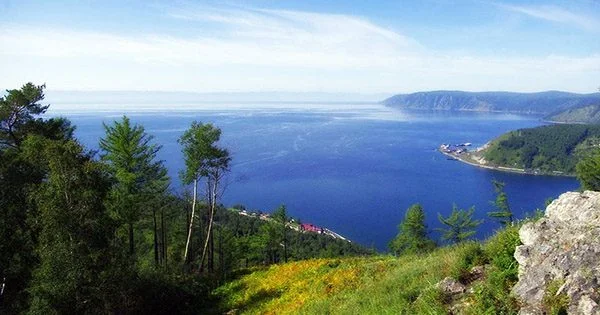
With steep slopes on the western beaches and softer slopes on the eastern shores, the lake hollow is not symmetrical. The meandering shoreline runs for some 1,300 miles (2,100 km), with large indentations at the bays of Barguzin, Chivyrkuysky, and Proval and at Ayaya and Frolikha inlets; the Svyatoy Nos Peninsula juts out into the lake from the eastern shore. The lake is divided into three basins: North, Central, and South, with depths about 900 m (3,000 ft), 1,600 m (5,200 ft), and 1,400 m (4,600 ft), respectively.
In the past, Lake Baikal had a significant influence on Russian literature. It is sometimes referred to as the Sacred Sea and symbolizes Russia’s unspoiled beauty. The age of Baikal is thought to be between 25 and 30 million years, making it the oldest lake in recorded geological history. It stands out among other sizable high-latitude lakes because the sediments there have not been swept away by advancing continental ice sheets.
Lake Baikal is the only confined freshwater lake in which direct and indirect evidence of gas hydrates exists. Baikal contains some 45 islets and islands, the largest of which are Olkhon (about 270 square miles (700 square km)) and Bolshoy (Great) Ushkany (3.6 square miles (9.4 square km)). The influx of water into the lake is primarily from rivers, chiefly the Selenga. The only outflow is through the Angara River, a tributary of the Yenisey.
According to Baikal Nature, Lake Baikal is a key figure in numerous regional origin myths and is frequently mentioned in Russian folklore. It attracts more than 500,000 tourists a year, according to the Siberian Times. The lake is surrounded by mountains; the Baikal Mountains on the north shore, the Barguzin Range on the northeastern shore and the Primorsky Range stretching along the western shore. The mountains and the taiga are protected as a national park.
The lake is fed by as many as 330 inflowing rivers. The main ones draining directly into Baikal are the Selenga, the Barguzin, the Upper Angara, the Turka, the Sarma, and the Snezhnaya. It is drained through a single outlet, the Angara. Though it is in southern Siberia, the lands around Lake Baikal are generally warmer than the rest of the area because large bodies of water have a moderating force.
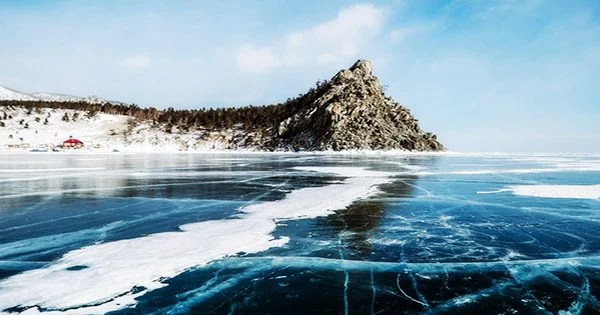
The lake’s abundance of indigenous plants and animals is of exceptional significance to the study of evolution. A network of protected areas with outstanding scenic and other natural assets surrounds it as well. Baikal is one of the clearest lakes in the world. During the winter, the water transparency in open sections can be as much as 30–40 m (100–130 ft), but during the summer it is typically 5–8 m (15–25 ft). Baikal is rich in oxygen, even in deep sections, which separates it from distinctly stratified bodies of water such as Lake Tanganyika and the Black Sea.
Lake Baikal is in a rift valley and up to 2,000 earthquake tremors are detected each year. The earthquakes deepen the lake and increase its size. Some geophysicists think that Lake Baikal is an ocean being born. The shores drift farther apart by 2 cm (0.78 inches) a year, the same rate at which Africa and South America drift apart. There are 236 species of birds that inhabit Lake Baikal, 29 of which are waterfowl. Although named after the lake, both the Baikal teal and Baikal bush warbler are widespread in eastern Asia.
Baikal’s climate is much milder than that of the surrounding territory. Winter air temperatures average −6 °F (−21 °C), and August temperatures average 52 °F (11 °C). The lake surface freezes in January and thaws in May or June. The water temperature at the surface in August is between 50 and 54 °F (10 and 12 °C) and reaches 68 °F (20 °C) in the offshore shallows. Waves can be as high as 15 feet (4.6 metres). The water is very clear; from the surface one can see to 130 feet (40 metres). Its salinity is low, and it contains few minerals.
According to the UNESCO World Heritage Commission, Lake Baikal is sometimes called the “Galapagos of Russia” because of its exceptional biodiversity and importance to evolutionary science. The age, isolation and deep oxygenated water of Lake Baikal have resulted in one of the world’s richest freshwater ecosystems. There are between 1,500 and 1,800 animal species at different depths, and hundreds of plant species live on or near the surface. The majority of the species are endemic to Baikal.
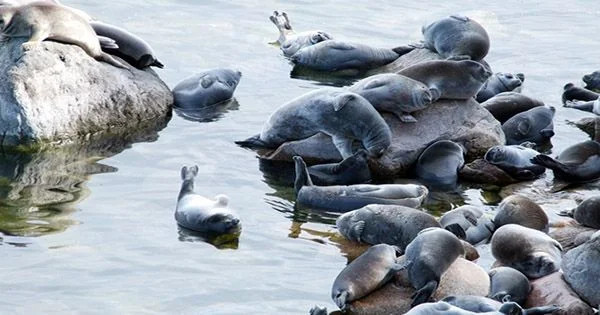
More than 50 species of fish live in Lake Baikal. Aquatic invertebrate species include more than 100 species of flat worms, more than 700 species of anthropods (insects, arachnids and crustaceans) and more than 170 species of mollusks. These invertebrates all help purify the water. There are dozens of tree species, including cedar, fir and spruce, growing in the Lake Baikal area. Some of the trees are up to 800 years old. The Angara pine tree is native to the area.
At least 18 species of sponges occur in the lake, including about 15 species from the endemic family Lubomirskiidae (the remaining are from the nonendemic family Spongillidae). Most sponges in the lake are typically green when alive because of symbiotic chlorophytes (zoochlorella), but can also be brownish or yellowish. A pulp and paper mill built on Lake Baikal’s southern shore in 1966 drew strong environmental protests from Soviet scientists and writers because its wastes were polluting the water, and in 1971 the Soviet government adopted a decree to protect the lake from polluting emissions. Further pollution controls were resisted, however, and industrial waste at the site remained a concern in the late 1990s.
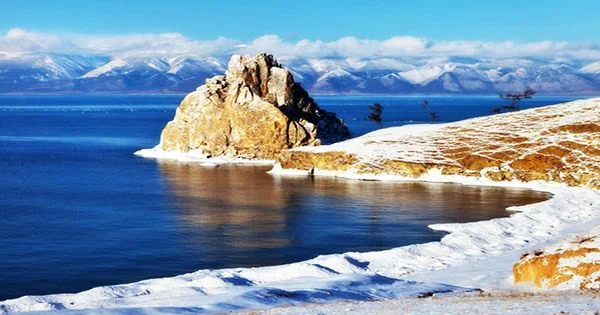
As Russia and Mongolia have become increasingly industrialized and tourism has increased, Lake Baikal has faced more and more threats to its environment. Additionally, climate change is threatening its ecosystem. Water temperatures and ice cover have already changed. The popularity of Lake Baikal is growing from year to year, but there is no developed infrastructure in the area. For the quality of service and comfort from the visitor’s point of view, Lake Baikal still has a long way to go.
